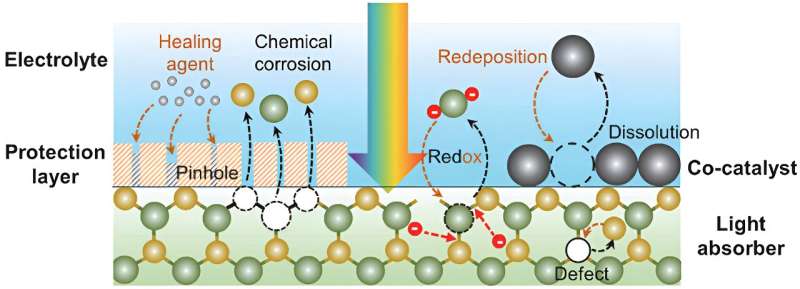This article has been reviewed according to Science X's editorial process and policies. Editors have highlighted the following attributes while ensuring the content's credibility:
fact-checked
trusted source
proofread
Exploring self-healing mechanisms for stable photoelectrochemical water splitting

Achieving stability poses a significant challenge in the practical implementation of photoelectrochemical (PEC) water splitting. The main factors affecting the long-term stability of PEC devices are chemical- and photo-corrosion of the semiconductor light absorbers, along with damage to the surface protection layer and the loss or reconstruction of the active centers of the co-catalysts.
Introducing the concept of self-healing provides new strategies to enhance the stability of the semiconductor light absorbers, protection layer and co-catalysts in PEC water-splitting studies. Continuous exploration of these dynamic repair strategies is expected to promote the long-term stability of the PEC devices.
Recently, a research team led by Prof. Yanbo Li from University of Electronic Science and Technology of China, reviewed the deactivation mechanisms of different semiconductor light absorbers, protection layers, and co-catalysts under operational conditions and the corresponding regeneration and repair strategies. This review was published in the Chinese Journal of Catalysis.
The degradation mechanisms of different semiconductor light absorbers, protection layers and co-catalysts under operational conditions are as follows: Narrow bandgap semiconductors, such as Si-based (n-Si or p-Si) or III-V semiconductors (GaAs, InP, etc.), predominantly experience chemical corrosion from the electrolyte, leading to unstable physicochemical properties and accelerated corrosion under illumination or applied bias.
For semiconductors with suitable bandgaps, such as non-oxide semiconductors (e.g., metal sulfides/selenides, nitrides, oxynitrides, phosphides, etc.), are susceptible to photogenerated hole oxidation due to thermodynamic factors; metal oxide semiconductors, such as Cu2O, are also prone to photogenerated electron reduction due to thermodynamic factors; thermodynamically stable metal oxide semiconductors, such as BiVO4, face photocorrosion driven by kinetics, resulting in the dissolution of light-absorbing species and destruction of lattice structure.
Surface protection layers, on the other hand, encounter limitations from parasitic light absorption and pinhole phenomena, diminishing their effectiveness in corrosion protection. Meanwhile, co-catalysts face constraints arising from activity decay and parasitic light absorption, ultimately impacting the stability of the photoelectrode.
To address these challenges, the corresponding self-healing mechanisms are as follows: intrinsic self-healing of active species in light absorbers and co-catalysts after damage, intrinsic self-healing of defective sites in semiconductors affecting light-absorbing properties, extrinsic self-healing of damage locations in conformal protection layers, and thickness self-limitation of films with self-healing against parasitic light absorption in surface modification layers.
The realization of these self-healing mechanisms, in addition to the bias or photovoltage provided by the working conditions in PEC water splitting, usually requires the addition of an ion source of the lost active species or an additional healing agent in the electrolyte. The magnitude of the bias provided under the working conditions as well as the number and concentration of the species added to the electrolyte determine the self-healing ability of PEC water splitting.
The study of additives in the electrolyte under working conditions will be one of the focuses of future research on the self-healing of different photoelectrodes in PEC water splitting.
More information: Chao Feng et al, Self-healing mechanisms toward stable photoelectrochemical water splitting, Chinese Journal of Catalysis (2024). DOI: 10.1016/S1872-2067(23)64648-0
Provided by Chinese Academy of Sciences





















